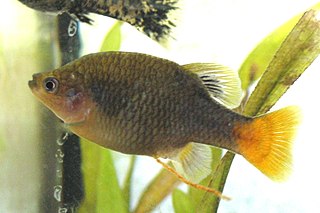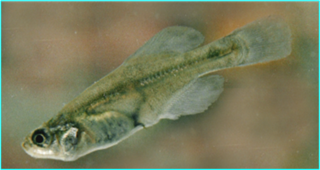
Goodeidae is a family of teleost fish endemic to Mexico and some areas of the United States. Many species are known as splitfins. This family contains about 50 species within 18 genera. The family is named after ichthyologist George Brown Goode (1851-1896).

The Ash Meadows killifish is a species of killifish from the subfamily Empetrichthyinae, part of the family Goodeidae, which was first documented by C. H. Gilbert in 1893 and historically occupied numerous springs near Ash Meadows, Nye County, Nevada, United States. This species was last seen in 1948 and is believed to have gone extinct in the early 1950s, likely as a result of habitat alteration and competition with and predation by introduced crayfish Procambarus clarkii, mosquitofish, black mollies, and bullfrogs.
The bulldog goodeid is a species of goodeid. It is endemic to stagnant and slow-flowing waters in the Lerma–Chapala, Presa de San Juanico and Balsas basins in west-central and southwestern Mexico. Despite its relatively wide range, it is generally uncommon. This is possibly the most predatory goodeid, it feeding on other fish, crayfish, insects and other invertebrates. At up to at least 14.3 cm (5.6 in) in standard length, this is likely the second-largest goodeid, after Goodea atripinnis.

The butterfly splitfin or butterfly goodeid, Ameca splendens, is a bony fish from the monotypic genus Ameca of the splitfin family (Goodeidae). It was formerly found throughout the Ameca River drainage in Mexico; the type locality is Rio Teuchitlán in the vicinity of Teuchitlán, Jalisco. The species was only ever found in an area about 10 miles (15 km) in diameter.
The bold characodon is a species of fish in the family Goodeidae that is endemic to Mexico. Its habitat is springfed ponds and small creeks with still or slow flowing water. It can reach lengths of 48 millimetres (1.9 in).
The Parras characodon is a species of goodeid fish once endemic to Coahuila, Mexico. Its natural habitats were destroyed between 1900 and 1953, and no records have been made in the last century; it is considered extinct, although the validity of this taxon and where the actual type locality is are subject to some doubt. The specific name honours the American herpetologist and ichthyologist Samuel Garman (1843-1927).

The rainbow goodeid is a species of fish in the family Goodeidae endemic to Mexico.
The blackspot allotoca, also known as the blackspot goodeid, tailspot goodeid, or tiro manchado, is a critically endangered species of fish in the family Goodeidae, endemic to the Lago de Magdalena basin near Guadalajara in Jalisco, Mexico.
The striped goodeid, bluetail goodeid or bluetail goodea is an endangered species of fish in the family Goodeidae. Its genus Ataeniobius is monotypic. It is endemic to the Río Verde and associated waters, including the Media Luna and Los Anteojitos lakes, in San Luis Potosí, Mexico. The specific name of this fish honours its discoverer, the America evolutionary biologist William Lawrence Tower (1872–1955) of the University of Chicago.
The Mezquital pupfish is a species of pupfish in the family Cyprinodontidae. It is endemic to Durango in Mexico. This species was described by Robert Rush Miller in 1976 from a pond which was fed by hot springs within the basin of the Río del Tunal, approximately 9 kilometres (5.6 mi) east of Durango City at an altitude of about 1,880 metres (6,170 ft). The specific name honors the American ichthyologist Seth Eugene Meek (1859-1914), a pioneer of the study of the freshwater fish of Mexico.
The dark-edged splitfin is a species of fish in the family Goodeidae endemic to Mexico. It is a live-bearing, cold-water fish from the mountains of Mexico. The species is incredibly temperature sensitive. If water is too cold, all offspring turn out to be male. If water is too hot, females will birth their first brood of only 1–3 fry and then die shortly thereafter, which makes it very difficult to maintain a colony. It is also a primarily carnivorous species that eats a variety of insects. Girardinichtys multiradiatus is an endangered species with multiple population threats with little conservation efforts put in place to protect the species.

The Chapultepec splitfin, known locally as mexcalpique, is a critically endangered species of fish in the family Goodeidae. It is endemic to Mexico and was originally restricted to lakes and wetlands in the Valley of Mexico, including Lake Texcoco. Through man-made channels it was able to spread to the upper Pánuco River basin. Most native populations disappeared as they were at or near Mexico City, with the waters either being reclaimed, drained, heavily polluted or infested with introduced species. Today the Chapultepec splitfin is only known to survive in three lakes in the Chapultepec park of Mexico City, Lake Xochimilco, Lake Zumpango, Laguna de Tecocomulco northeast of the City where perhaps introduced, and parts of the Pánuco River basin. Most of these remaining populations are small. This species was originally described as Cyprinus viviparus in 1837 by Miguel Bustamante y Septién with the type locality given as "Mexico". In 1860 Pieter Bleeker raised the genus Girardinichthys with a new species Girardinichthys viviparus as its type species, this subsequently proved to be a taxonomy of Cyprinus viviparus.
Goodea gracilis, with the common name: dusky splitfin, is a species of freshwater fish in the family Goodeidae.

Goodea is a genus of splitfins that are endemic to Mexico. They are found in a wide range of habitats in several river basins that originate in the Central Plateau, such as Pánuco, Lerma–Chapala–Grande de Santiago and Balsas. Overall this genus is among the most widespread and successful splitfins, although they also have declined and the relatively restricted G. gracilis is considered vulnerable by the IUCN. This genus includes the largests splitfins, reaching a standard length of up to 20 cm (8 in). They are primarily herbivores, but also take small organisms like tiny crustaceans and snails. The is named in honour of the American ichthyologist George Brown Goode (1851-1896).

The Highland splitfin is a species of splitfin endemic to Mexico where it is found in the Lerma River basin. This species grows to a length of 5 centimetres (2.0 in) TL. It is the only known member of its genus, although some authorities have Hubbina as a subgenus of Girardinichthys and add Girardinichthys ireneae to the subgenus, even treating this taxon as a synonym of G. ireneae. This species was described by Don Fernando de Buen y Lozano in 1940 with the type locality given as Cointzio, Michoacán. The name of the genus honours the American ichthyologist Carl Leavitt Hubbs (1894-1979) while the specific name honours Clarence Lester Turner (1890-1969), thus honouring two ichthyologists who worked on a review of the Goodeidae in 1939.

The Balsas splitfin is a species of fish in the family Goodeidae. It is endemic to Mexico where it occurs in the states of Morelos and Michoacán. This fish was formally described as Goodea whitei by Seth Eugene Meek in 1904 with the type locality given as Yautepec in Morelos. The specific name honours E. A. White of the Interoceanic Railway of Mexico for his interest in and support of Meek's work.

The redtail splitfin or redtail goodeid is a species of goodeid fish from the family Goodeidae and subfamily Goodeinae. Like other members of Goodeinae, the redtail splitfin is native to Mexico and a livebearer. However, the goodeid mating system differs in several ways from the more common livebearing fish from the family Poeciliidae that includes guppies and swordtails. While no goodeid species is a very popular aquarium fish, the redtail splitfin is one of the most popular. Only the male has the red-orange tail for which it is named. Its specific name honours the collector of the type, Gustav Eisen (1847–1940) who was Curator of Marine Invertebrates at the California Academy of Sciences in San Francisco, California.
Allotoca meeki, commonly known as the Zirahuen allotoca or the tiro de Zirahuén, is a species of fish endemic to Lake Zirahuén, a small endorheic mountain lake in Michoacán state of central Mexico.

The Seminole killifish is a fish of the genus Fundulus, endemic to the U.S. state of Florida.

Goodea luitpoldii, the green goodea, is a species of killifish from the family Goodeidae which is endemic to the drainage basin of the Lerma River and the Grande de Santiago River in Mexico. This species was Species description described as Characodon luitpoldii by the Franz Steindachner in 1894 with the type locality given as Lake Pátzcuaro in Michoacán. The identity of the person honoured in its specific name is unknown but it is thought likely to be Luitpold, Prince Regent of Bavaria (1821-1912) whose daughter, Princess Therese of Bavaria (1850-1925) was an explorer and amateur naturalist and she collected the type.










